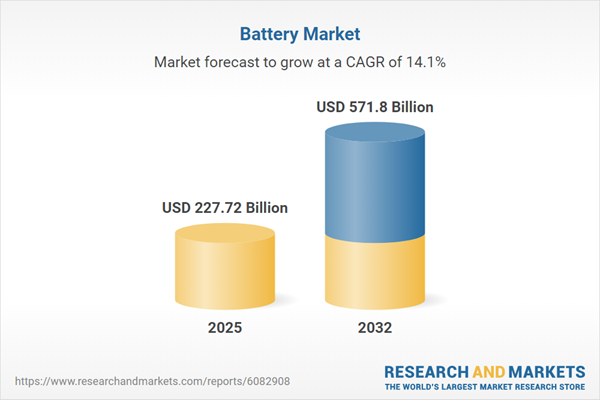Speak directly to the analyst to clarify any post sales queries you may have.
The battery market is advancing at a fast pace, reshaping value creation strategies across energy storage, electric mobility, and power grid sectors. Senior decision-makers require actionable, data-driven intelligence to manage evolving risks and seize strategy-aligned opportunities within this dynamic landscape.
Market Snapshot: Battery Market Size and Growth Trends
The global battery market recorded significant expansion, reaching USD 199.04 billion in 2024, rising to USD 227.72 billion in 2025, and is projected to maintain a CAGR of 14.10% to attain USD 571.80 billion by 2032. This consistent acceleration is rooted in high adoption of electric vehicles, integration with renewable energy, and steady innovation in manufacturing technologies. Infrastructure improvement, supportive regulations, and the convergence of mature and emerging economies foster this momentum. Decision-makers will find that growth opportunities continue to diversify as investment and policy frameworks evolve globally.
Scope & Segmentation: Battery Market Coverage
This comprehensive report offers clear segmentation and strategic coverage for the battery market, enabling granular insight into value drivers, technology relevance, and geographic dynamics:
- Battery Technologies: Reviews diverse chemistries and platforms, including Lead Acid (AGM, Flooded, Gel, VRLA), multiple Lithium Ion types (LCO, LFP, NCA, NMC), as well as Nickel Cadmium and Nickel Metal Hydride systems. Analyzes deployment maturity, technology roadmaps, and alignment with industry priorities.
- Application Areas: Examines use in Aerospace (avionics, defense, satellite, unmanned aerial systems), Automotive (EV, HEV, PHEV, Start-Stop), Consumer Electronics (laptops, smartphones, wearables, power banks), Energy Storage Systems (commercial, residential, utility scale), Industrial (power tools, robotics, UPS), and Medical (implantable, portable devices), highlighting segment-specific requirements and growth avenues.
- Form Factors: Explores a spectrum of cell types, including Coin, Cylindrical (notably 18650, 21700), Pouch, and Prismatic, focusing on integration flexibility, safety, and alignment with end-user needs.
- Capacity Ranges: Details market requirements for batteries with capacities above 10Ah, below 1Ah, and the mid-range (1Ah to 10Ah), mapping these to target industries and use cases.
- Geographic Regions: Covers the Americas (including United States, Canada, select emerging markets), Europe, Middle East & Africa (such as United Kingdom, Germany, other core regions), and Asia-Pacific (featuring China, India, Japan, and additional high-impact countries), analyzing regulation, investment environment, and demand patterns.
- Market Players: Profiles major industry leaders including Contemporary Amperex Technology Co., Limited, LG Energy Solution, Panasonic Holdings Corporation, BYD Company Limited, Samsung SDI, SK On, China Aviation Lithium Battery, EVE Energy, Gotion High-tech, and Envision AESC Group, with focus on strategic positioning, technology expertise, and geographic coverage.
Key Takeaways for Battery Market Leaders
- Next-generation battery chemistries, such as solid-state and silicon-based variants, are gaining traction and bringing notable improvements in energy density, charging rates, and operational safety across numerous end-markets.
- Convergence between mobility, grid, and industrial sectors is driving a new wave of cross-industry partnerships, with collaboration set to accelerate innovation cycles and enhance deployment efficiency.
- Increasing emphasis on recycling and circular economy initiatives strengthens compliance with regulatory requirements and supports greater stability in critical mineral sourcing.
- Adoption of advanced digital solutions—including artificial intelligence for production optimization and digital twins for predictive maintenance—minimizes downtime and unlocks new efficiencies in battery manufacturing.
- Shifting global regulations and geopolitical factors are prompting manufacturers and suppliers to refocus on supply chain diversification, localization, and sourcing resilience for greater business continuity.
- Market leaders are leveraging consortium-based approaches and strategic alliances to accelerate technology standards, reduce commercialization barriers, and scale advanced battery solutions for broader industry adoption.
2025 Tariff Impact: Navigating Shifting U.S. Policy
Recent U.S. tariffs on battery components are fundamentally altering global sourcing and investment strategies. Companies are actively redirecting procurement to secure jurisdictions, establishing new regional partnerships, and adjusting technology choices to reduce reliance on constrained imports. This evolution is reshaping financial models and amplifying the importance of adaptive supply chain and operational strategies in response to rapidly changing regulatory expectations.
Methodology & Data Sources
This analysis is supported by a robust methodology, integrating secondary sources—including industry literature and technical publications—with in-depth primary research. Comprehensive interviews with executives and expert stakeholders enable triangulation, ensuring findings are validated and actionable for strategic and operational planning.
Why This Report Matters for Battery Market Leadership
- Enables market leaders to develop innovation-driven strategies, aligned with emerging technologies and shifting regulatory frameworks for the battery market.
- Supports supply chain and investment decisions by providing clarity on operational risks, geographic dynamics, and tariff-related challenges.
- Equips senior executives with the insights required to adapt business models as demand patterns evolve and structural shifts reshape the sector.
Conclusion
Decision-makers using these strategic insights are positioned to better anticipate industry changes, address operational risks, and capture growth opportunities across the global battery value chain.
Table of Contents
3. Executive Summary
4. Market Overview
7. Cumulative Impact of Artificial Intelligence 2025
Companies Mentioned
The companies profiled in this Battery market report include:- Contemporary Amperex Technology Co., Limited
- LG Energy Solution, Ltd.
- Panasonic Holdings Corporation
- BYD Company Limited
- Samsung SDI Co., Ltd.
- SK On Co., Ltd.
- China Aviation Lithium Battery Co., Ltd.
- EVE Energy Co., Ltd.
- Gotion High-tech Co., Ltd.
- Envision AESC Group Ltd.
Table Information
| Report Attribute | Details |
|---|---|
| No. of Pages | 180 |
| Published | November 2025 |
| Forecast Period | 2025 - 2032 |
| Estimated Market Value ( USD | $ 227.72 Billion |
| Forecasted Market Value ( USD | $ 571.8 Billion |
| Compound Annual Growth Rate | 14.1% |
| Regions Covered | Global |
| No. of Companies Mentioned | 11 |









